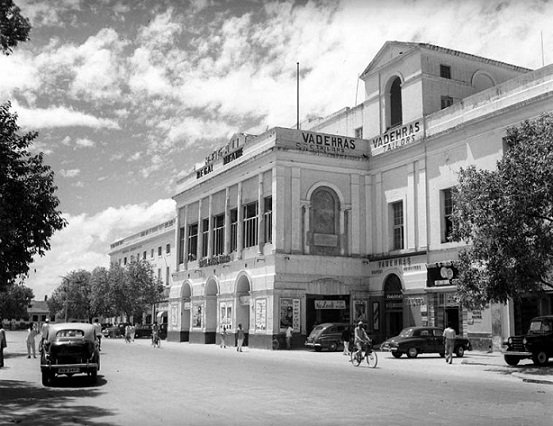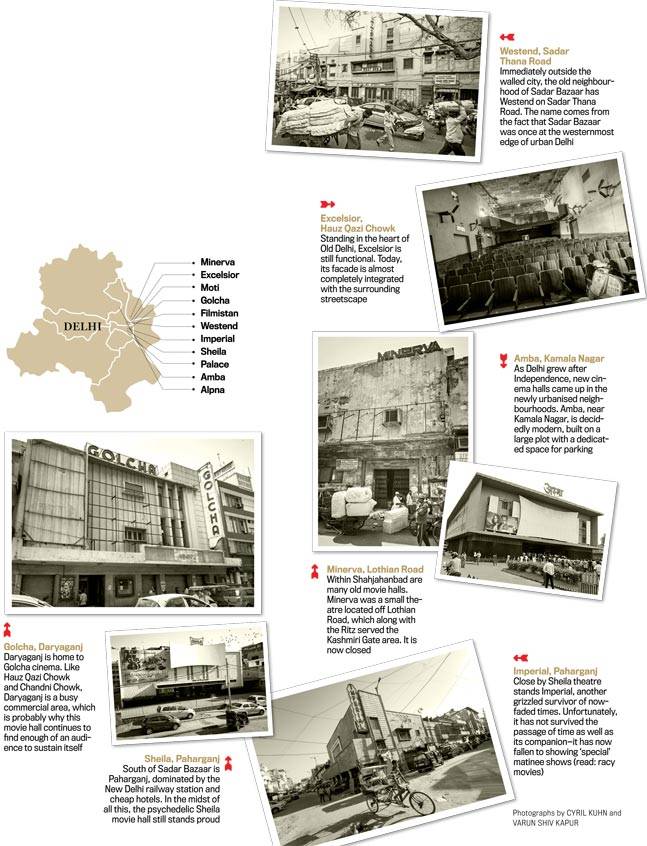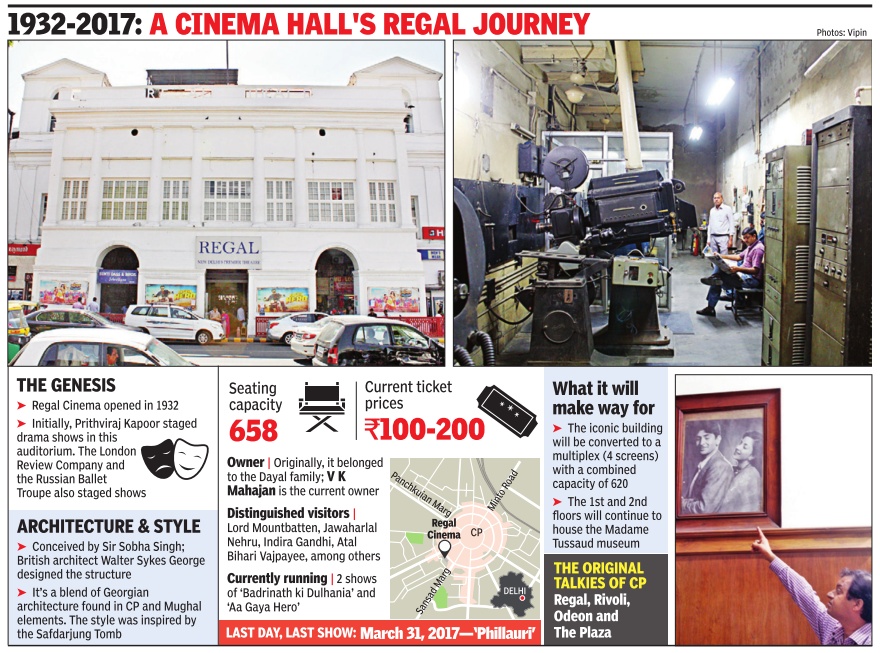Delhi: Cinema halls/ theatres
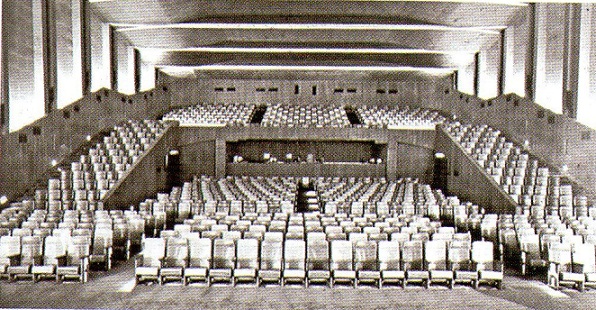
Chanakya would underscore the bigness of its screen by beginning the screening of Cinemascope and 70mm films on about three quarters of the screen, leaving a blank, white border or rim on all four sides. It was Chanakya’s way of saying: This is how big other cinemas’ widescreen is. Then it would expand the image to cover the whole screen, under the name Chanakyarama.
By 1972 it started projecting normal 35mm films on its widescreen, under the name Chanakyascope. This of course meant cropping off the top and bottom of the image, but Delhiites were delighted.
In 1975 it installed an early version of surround sound (popularised in India by Dolby in the 1990s.)
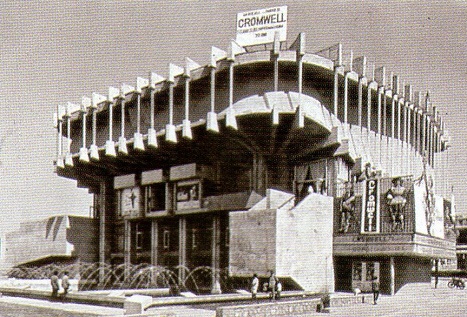
Chanakya got off to an inauspicious start in 1970 with Mera Naam Joker, which was the most keenly awaited film since Sangam (1964), bombing so badly that it had to be taken off after a week.
Cromwell was, in 1971, the first film to be screened in Chanakyarama.
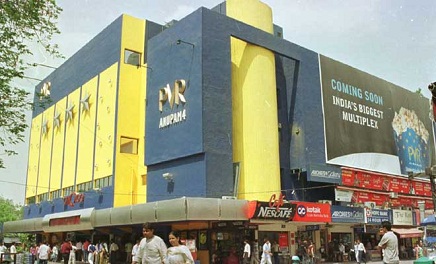
That distinction had been grabbed as many as 33 years before, in 1964, by the 3-screen Sapphire, Emerald, Blue Diamond: Chennai/ Madras.
indeed, by the 1970s, two-screen theatres were commonplace in Bangalore, Hyderabad and Madras.
These are newspaper articles selected for the excellence of their content.
Additional details/ photos may kindly be sent as messages to the Facebook page, Indpaedia.com. Indormation used will be acknowledged in your name. |
Contents |
Source article
New cinema scene in Delhi
By Namya Sinha, Hindustan Times, October 07, 2011 Hindustan Times
Delhi’s cinema halls
1930s
Lights camera action: Regal cinema opened in 1932 in Connaught Place. In 1933, Plaza Cinema opened nearby. In 1939, Moti Hall in Old Delhi revamped itself from being a venue for live theatre performances to a movie hall that screened Bollywood talkies
1940
Old Delhi is cinema central: As talkies became more and more popular, eight to nine movie halls opened up in Old Delhi around this time, including Ritz, Novelty, Jagat and Kumar Talkies. They were referred to as ‘bioscope’ or ‘mandwa’ and known by the area they were located in
1950s
Comfort cinema: Delite Cinema and Golcha opened in 1954 in Old Delhi.
Delite was the first air conditioned hall in North India. Its foyers had the look and feel of pre-1947 British/ Maharaja-style luxury.
In 1956, Eros Cinema opened in Jungpura. “At that time, movies ran for 50-60 weeks. But now, people get a lot of TV channels, so films hardly last for 4 weeks,” says NR Saini, the owner of Golcha
[Not quite true. Even at their peak, only one or two films in a year would run for 50-60 weeks, and that in Bombay. Delhi's much smaller market would at best stretch films to 25 weeks. Sholay and Hum Aapke Hain Koun? Were among the few golden jubilees in Delhi.]
1960s
70mm in town: The Sheila movie hall, which opened in Paharganj in 1961, was India’s first 70 mm theatre.
Odeon expands its screen to 70mm and even conducts an unsuccessful trial run of Cinerama with 'How the West Was Won' in 1965.
Liberty, located in non-English speaking West Delhi, also installed 70mm equipment and a widescreen. This was unusual for a hall that never screened English films. However, as a reward it got to screen both Around the World (1967) and Sholay (1975): two 70mm films in a decade.
English films
Tiny Rivoli followed the all-India pattern of medium-sized halls in localities popular during the British Raj screening only English films. Shiela (Delhi’s biggest, till Vishal came along) and Odeon were too big to restrict themselves to English films. They would screen both English and Hindi-Urdu films.
In ‘old’ Delhi, Delite alone would sometimes screen English films (mainly dubbed European films, B-films as well as European art cinema) in normal shows, i.e. after 12 noon. Throughout India, in the state capitals as well as in the non-English speaking parts of the metropolitan cities, some cinemas that otherwise catered to films in the local language or Hindi-Urdu, would screen English films in the 10am show on Sundays (sometimes, Saturdays as well).
By the early 1970s, South Delhi, where house owners mostly spoke English, started beginning to count, vis a vis cinema central (old Delhi, with its huge but not affluent population) and the then swank central Delhi (the resident population of which was super-affluent but small). Therefore, English films moved to Chanakya and then Archana in Greater Kailash.
India was a very tiny market for English films, and would get them after they had run their course in small East Asian, ASEAN and Latin American countries. Within India, Bombay, Bangalore, Madras, Hyderabad and Calcutta had bigger English-speaking audiences than did Delhi/ North India (the Hindi belt still has the lowest literacy in India). Except for dubbed European films with lots of cheesecake, an English film would be released at only one hall at a time in Delhi, or even the other metros. ('That Man in Istanbul' was released at 4 Delhi theatres simultaneously, as were similar cheesecakey films)
The trend of releasing the same English film at a dozen or more halls within the national capital region is a 21st century trend, and a result of the post-1992 liberalisation and the consequent sudden increase in employment opportunities for English-speaking youths.
1970s
Single in the city: In 1970, Chanakya Cinema and Vishal Cinema opened. With a seating capacity of 1,400 people, Vishal was the largest movie hall in [Delhi].
Plaza launched its 70mm renovation only after 1967 and specialised in Russian (i.e. Soviet) blockbusters. Delhi’s longest running non-Indian (dubbed into English) film, screened at Plaza, was 'Gypsy camp vanishes into the blue' (USSR), because it had a topless scene.
1980s
Cinema goes west: Satyam [later, Cineplex] opened in 1980. It was the first movie theatre in Patel Nagar in West Delhi
1990s
Being single: In the early 1990s, there were only single screen halls in the Capital until the first multiplex of Delhi Anupam PVR Cineplex, opened in Saket in the year 1997. [All three South Indian metros have had two-screen cinemas since the 1970s. The 3-screen Blue Diamond, Sapphire, Emerald multiplex in Madras/ Chennai was without doubt India’s first multiplex and opened in the 1960s.]
2000s
Multiplexes boom: This decade was marked by the decline of single screen halls. In 2007, iconic Delhi theatre, Chanakya Cinema, also shut down, along with Archana (later,the NDTV office in Greater Kailash), Kamal and so many more. Odeon cinema became a part of Big Cinemas and now has two screens. Alankar Cinema in Lajpat reopened as 3Cs in 2002
The first Imax hall of the national capital region, Aeren Adlabs, opens in Kaushambi but does badly because of its location. And yet it got 'Superman III' (partly in 3D) almost a day before its US release. (Aeren R IMAX Theatre at Rap Adlabs Multiplex, Pacific Mall, Sahibabad, opened in 2005.)
2010s
Director’s Cut, which opened in 2011 on the 3rd floor of Ambience Mall, Vasant Kunj, Delhi, was the most expensive theatre of its time—more than twice as expensive as the next costliest. It has a restaurant. The bookstore came in when the owners considered what all would a movie lover want.
The four auditoriums have different seating capacities, with the smallest being 25 people. These can be booked by people for private screenings of movies from a collection of 300 select films. The halls will also screen the latest flicks. There’s another concept called Director’s Rare, under which, two shows per day will be dedicated to rare, vintage or award-winning films from all over the country and world. The reclining chair in the auditoriums have a push button, which on pressing, will instruct a server to come with an iPad menu. The orders are directly recorded in the kitchen and delivered to your seat.
The restaurant and shops are open to those who don’t want to watch a movie, but simply want to hangout and soak in the cinema.
Tickets: Weekdays: Morning (Rs 600), Evening (Rs 850), Weekend (Rs 1,050)
Aerated drinks: Rs100 (plus taxes)
Popcorn: Rs. 120 - Rs. 130 plus taxes
Meal for two in the restaurant: Rs. 2,000 (approx)
Single screen halls
Liberty, 2016
The Times of India, December 19, 2016
In 1968 Liberty (along with Amba) was renovated to screen India’s first 70mm film Around the World and its sound system was upgraded to six-track stereophonic. In 1975 when India’s second 70mm, stereophonic-sound film was released, once again Liberty was chosen (this time along with Plaza). Liberty was thus the theatre of choice for Hindi-Urdu films in 70mm.
Amba
Avijit Ghosh, May 15, 2023: The Times of India

From: Avijit Ghosh, May 15, 2023: The Times of India
New Delhi : Born in the spring of 1963, Amba cinema soon became a part of north Delhi’s bustling heart and its being. The theatre opened with director O P Ralhan’s high-strung melodrama, ‘Gehra Daag’. Rajendra Kumar, known as Jubilee Kumar in those days, and Mala Sinha played the leads. Kumar passed away in 1999. But at a time when many singlescreen theatres have fallen on hard times and their numbers dwindle a cross the city, Amba lives on strong. The movie theatre turned 60 last month, joyfully celebrating its diamond jubilee.
For decades, DU’s North Campus students have been amo ng Amba’s core patrons. The capacious air-conditioned theatre, with a seating capacity of 1,053, also attracts a motley gathering from other nearby areas: Kamla Nagar, Subzi Man di, Vijay Nagar, Mukherjee Nagar & Model Town. “In the 1980s, the audience used to be a mix of different social classes, from the affluent to the working class. Even wrestlers from nearby akharas came,” remembers city-chronicler Vivek Shukla.
On social media, several cine-goers recounted their association and relived their memories of the theatre. They recalled watching India’s first 3D film, ‘Chhota Chetan’ (1985), and other blockbusters, such as ‘Hum Aapke Hain Kaun’. One post recalled how Manoj Kumar’s ode to the plough, ‘Upkar’, was shown at Amba an d Alpana and the lone print had tobe shuttled between the two cinema halls. “My friend had to elbow his way to the ticket counter for Shah Rukh Khan’s ‘Deewana’,” reminisces journalist Alok. Amitabh Bachchan movies such as ‘Muqaddar Ka Sikandar’, ‘Laawaris’, ‘Sharaabi’ ran to packed houses at Amba. “But the only film which celebrated its silver jubilee was ‘Sholay’ (1975),” says cinema manager Kausar Siddiqui. Major stars to visit the theatre include Pradeep Kumar and Sanjay Dutt.
Started by Shiv ShankerLall and Bhawani Shanker, Amba has remained a family business, says the cinema’s director, Ambani Shanker. “To keep up with the changing times we have incorporated the latest digital projection and sound systems. We also offer multiple movie screenings and maintain reasonable prices for our audiences,” he texted.
Designed by architects Powar & Powar, Amba’s compound is roughly the si ze of a hockey field with plenty of parking space. The exteriors are brick red and dark green. At the back you can still see the abandoned front stall ticket counter of yore. I nside, the look is neat. With its wooden balustrade and marble steps, the staircase leading to the balcony catches the eye.
Both middle stall and front stall tickets cost Rs 75. Add another Rs 25 to buy a seat in the rear stall. A balcony ticket is Rs 200. Popcorn costs Rs 80 and hot coffee Rs 40. Five shows are hosted every day.
Like the entire film industry Amba, too, endured hard times during the peak Covid-19 period. But now, despite construction work nearby, the film public i s crowding the counters again. “Footfalls have increased. Tickets were sold out for 21 shows of Pathan. Even those who don’t regularly visit theatres turned up to watch the film,” says Siddiqui. “Last Sunday one of The Kerala Story shows was also “Houseful”. The film is drawing decent crowds,” he says.
It’s Monday afternoon and the matinee show has just started. Four students, tickets in hand, rush towards the balcony door. “How much have we missed?,” one of them asks as they are ushered in. It’s a question every film buff would have asked sometime.
Pre-Independence built and running
Varun Shiv Kapur , Silver Screens “India Today” 24/4/2017
Regal, 1932-2017
The white stone letters on the building's Gregorian facade read: RE AL THEAT E. The missing letters are a painful pointer to the steadily declining fortunes of this Connaught Place icon. Now, after several pronouncements of its demise, Regal theatre is finally going out of business.
The hall, which opened in 1932 and fondly calls itself “New Delhi's premiere theater“, will pass into history on March 31, with the last screening of Anushka Sharmastarrer, Phillauri. “It has been decided by the management to close down the business from the premises wef 3132017“, reads a notice, signed by owner V K Mahajan, hanging in the large central porch of the theatre.
The recent collapse of two buildings in CP and subsequent notices from the municipal council to old buildings to prove their structural integrity was the final nail in the coffin of this struggling enterprise.
In a communication to its employees, the Regal management has asked them to clear their dues.
“The structural engineer has stated that as our building is very old, its inspection will require a long period and we shall not be in a position to carry out business activity as it is likely to endanger the life and property of employees and visitors,“ it states. Regal's imminent clo sure evokes a flood of memories among old employees. “It will be the end of an era. Both historic and memorable,“ says Aman Singh Verma, the oldest serving employee of Regal who has been working as an accountant since 1977.
Sitting beside the heavy Godrej safe he has worked with for 40 years, Verma recalls the golden age of Regal.“We used to be Raj Kapoor's favourite cinema hall. Now, the shows might be running empty but there was a time when people would start lining up a day before the premier. The hall would be decorated with flowers like a marriage venue, patrons would get specially printed pamphlets and big filmstars like Raj Kapoor and Nargis would come for the red carpets,“ he says.
Big portraits of these mega stars are on display in the crescent gallery right outside the hall. The proud list of patrons which Regal has welcomed includes people like Lord Mountbatten, Jawaharlal Nehru as well as his daughter Indira Gandhi.
Now, visitors are hard to find. The collections from two shows of `Aa Gaya Hero' have fetched just Rs 8,999 while two shows of `Badrinath ki Dulhania' got Rs 12,185. “With collections so low, it is impossible to run a theatre and pay its employees. There were times when we celebrated back-toback golden jubilees. Now, I don't even remember when we had a last house-full,“ says Verma sadly while displaying his old ledger.
“We have reached a stage where we get requests from young couples to book the VIP boxes which were meant for families,“ he says.
The signs of decay are everywhere and Regal is only a shadow of its former glory .“The seats are broken, the sound system is outdated and murals on the walls are falling apart. In the absence of regular maintenance, things have grown worse. That's why people have stopped coming,“ says Vijay Singh, the gatekeeper-cum-ticket-checker who has been working here for more than 23 years. The theatre, conceived by Sir Sobha Singh and designed by Walter Sykes George, the British architect who also designed St Stephen's college, started as a venue for dramatic performances from English and Russian theatre groups. It was only later, with the advent of talkies that Regal began showcasing Hindi movies while other CP theatres like Plaza and Rivoli focused on Hollywood flicks.
These famous vintage theatres slowly lost their charm and, one-by-one, were refurbished as multiplexes in last few decades. Regal remained the only singlescreen theatre in CP. Now, this heritage building with influences from Safdarjung tomb, too, may be converted into a multiplex.
“Instead of the current 658 seats, there are plans to have four screens with a total capacity of 620 seats. We are in the process of getting final NOCs but the procedure is tedious as the building is a heritage structure“ says Roop Ghai, the manager. Like Ghai and Verma, most of the 20 odd employees of the hall have been serving it for decades and are now worried about their future.
Whether Regal gets resurrected as a multiplex remains to be seen. What appears certain, though, is that a chapter in Delhi's cinematic history will come to an end when patrons leave the hall one last time on March 31.
The Chanakya experience, 1970-2007
Avijit Ghosh, Uber cool to USSR folk, they all loved it, September 22, 2017: The Times of India
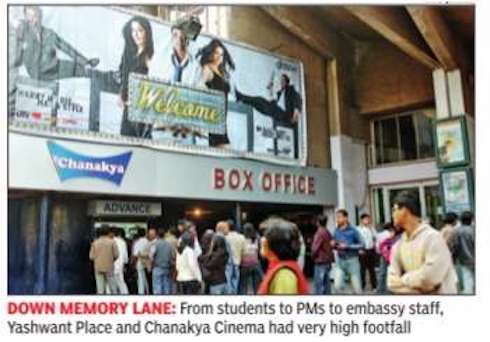
To the young and eager in the 1980s, Chanakya wasn't just another cinema hall. It was the place to be. Visiting Nirula's, part of the same structure, was almost mandatory after watching a Hollywood blockbuster.
Those who didn't have the taste for the fast food joint's chicken pot pie or couldn't afford its salami footlong, just walked over to the dozen odd eateries peddling momos, thukpa and chowmein in the complex.
In those pre-PDA (public display of affection) days, it would be common to see couples lounging in the sun, bodies rarely in touching distance. College students flaunting the latest in street fashion -attires often bought from Sarojini Nagar market -came from all over Delhi.Grunge too was in, especially in JNU. Many came for latenight shows taking DTC's 062, a late night special, back to the outskirts of the university. At the hostel, a cold dinner, kept on request to the mess staff, awaited them. Sometimes resident cats would have tasted it first.
But Chanakya wasn't just the blooming generation's haunt. In those pre-multiplex times, the state-of-theart theatre was also the preferred choice of the embassy crowd and the city's urbane gentry . Ramashankar Singh, a seller of paan and cigarettes in the complex for over four decades, says top politicians and actors of the time would visit the theatre though the names, barring Sheila Dikshit, escape his memory. What he remembers clearly is then Prime Minister Indira Gandhi visiting the adjacent commercial complex Yashwant Place. “She used to visit an art gallery ac companied by two cops,“ he recalls.
At Yashwant Place, you can buy leather garments, stone jewellery and other things that adorn the lives and living rooms of the wellheeled. The commercial complex was hugely popular among matronly tourists cum business people from the erstwhile Soviet Union. Even today , some shops have their nameplates in Russian.
Chanakya, which had opened in 1970, shut down in 2007. From all accounts, business in shops located in the complex suffered in greater or lesser degree. How much the collapse of Soviet Union and the rise of mallmultiplex culture also contributed to the decline is File photo open to guess.
On Thursday afternoon, when TOI visited Yashwant Place, most shops were bereft of any customers. Bittu Bhatt, employed with a handicraft shop, said sales were down 90% from the times when dozens of `foreigner ladies' would haggle over necklaces and paintings. “We suffered for 10 years. One only hopes business will improve now,“ said Singh, who can speak a smattering of Russian too.
With cinema coming back to the Chanakya complex on Friday , Bhatt is guardedly optimistic about an improvement in prospect. “We are hoping that some PVR filmgoers will also visit us and become our customers,“ he says. Another shopowner, who sells Chinese food, isn't so sure. “The multiplex also has a food court. Let us see if some of them come to us,“ he says.
See also
Delhi: Cinema halls/ theatres / Madras/ Chennai theatres/ cinemas / PVR (Priya Village Roadshow) group / Sapphire, Emerald, Blue Diamond: Chennai/ Madras /
